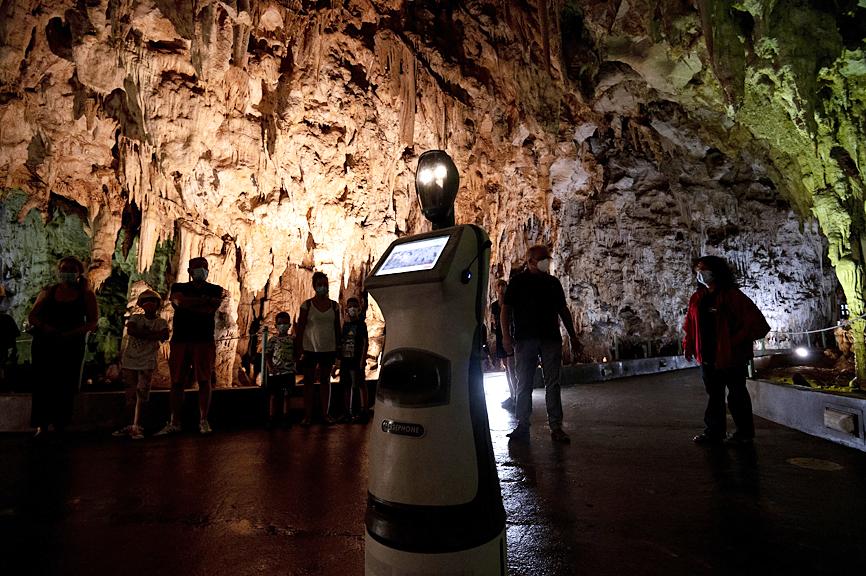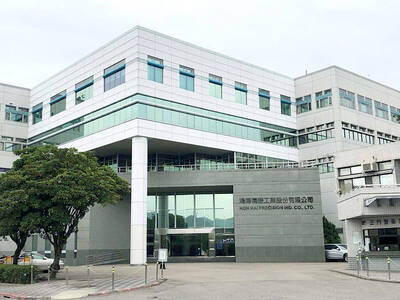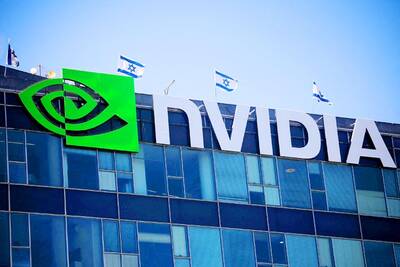Persephone is a tour guide in Greece, but perhaps not the type people are used to.
Billed as the world’s first robot tour guide inside a cave, Persephone has been welcoming visitors since the middle of last month to the Alistrati Cave in northern Greece, 135km northeast of Thessaloniki.
The multilingual robot covers the first 150m of the part of the cave that is open to the public. In the remaining 750m, a human guide takes over.

Photo: AP
The robot was named Persephone, because, according to one version of the ancient Greek myth, it was in a nearby plain that Pluto — the god of the underworld who was also known as Hades — abducted Persephone, with the consent of her father, Zeus, to take her as his wife.
The robot can give its part of the tour in 33 languages and interact at a basic level with visitors in three languages. It can also answer 33 questions, but only in Greek.
Nikos Kartalis, the scientific director for the Alistrati site, had the idea of creating the robot when he saw one on TV guiding visitors at an art gallery.
Seventeen years later, “we got our funds and the robot guide became a reality,” Kartalis told reporters.
The robot was built by the National Technology and Research Foundation and cost 118,000 euros (US$138,000).
“We already have a 70 percent increase in visitors compared to last year since we started using” the robot, Kartalis said. “People are enthusiastic, especially the children, and people who had visited in the past are coming back to see the robot guide.”
“It is something unprecedented for them, to have the ability to interact with their robot by asking it questions and the robot answering them,” he said. “Many foreign visitors couldn’t believe Greece had the capacity to build a robot and use it as a guide in the cave.”
The robot moves along a walkway, passing through an ornate landscape of stalactites and stalagmites. These varied formations can reach 15m tall and are seen throughout the cave’s nearly 1km walkway, which is accessible to people with limited mobility.
“This cave is one of the most beautiful, not only in Greece, but in Europe, as well,” Kartalis said. “It has stalactites and stalagmites in many shapes and colors, even red.”
He said the cave was 3 million years old and was first explored in 1974 by the Hellenic Speleological Society and a team of Austrian speleologists. It opened to visitors in 1998.
Persephone, with a white body, black head and two luminous eyes, moves on wheels, guiding visitors to the first three of eight stops along the walkway. She can do two more stops, but her low speed slows down the tour, which is conducted in three languages simultaneously. Persephone’s creators are considering ways to speed her up.
The robot’s begins by saying: “My name is Persephone, I am the daughter of the goddess Demeter and the wife of Pluto, the god of the underworld. I welcome you to my under Earth kingdom, the Alistrati Cave.”
Many visitors are intrigued by the robot guide.
“It was surprising for me. I’ve never experienced such a thing. Actually, honestly, I prefer a live guide, but it’s interesting doing it this way. And I like the pace of the robot. It goes slower, so I can look around,” said Patrick Markes, a Czech visitor.
Markes listened to the first three stops from the robot in his native language and the rest in English from a human tour guide.
“I should thank Persephone, our robot, she said very fine things,” said Christos Tenis, a Greek visitor. “I’m impressed by the cave. Of course, we had a flawless [human] guide, she explained many things. I’m very impressed.”
Persephone is not the only technology used inside the cave. There is a mobile app in which a visitor, scanning a QR code, can see the Alistrati Beroni. That is a microorganism that is only found in the cave, in the huge mounds of bat droppings left behind when the cave was opened and the bats migrated elsewhere.
Evdokia Karafera is one of the tour guides who partners with the robot.
“It is helpful, because it speaks many languages. There’s just a little delay in the touring,” she said. “Most find it fascinating, especially the children, and find it interesting that it speaks many languages.”
However, Karafera said that human tour guides cannot be completely replaced.
“Robots, at some point in the future, will take over many jobs. But I believe they cannot replace humans everywhere,” she said. “[Visitors say] the robot is interesting, original, but can’t substitute for the human contact with the guide and the conversation we can have on the way back.”

Shares in Taiwan closed at a new high yesterday, the first trading day of the new year, as contract chipmaker Taiwan Semiconductor Manufacturing Co (TSMC, 台積電) continued to break records amid an artificial intelligence (AI) boom, dealers said. The TAIEX closed up 386.21 points, or 1.33 percent, at 29,349.81, with turnover totaling NT$648.844 billion (US$20.65 billion). “Judging from a stronger Taiwan dollar against the US dollar, I think foreign institutional investors returned from the holidays and brought funds into the local market,” Concord Securities Co (康和證券) analyst Kerry Huang (黃志祺) said. “Foreign investors just rebuilt their positions with TSMC as their top target,

REVENUE PERFORMANCE: Cloud and network products, and electronic components saw strong increases, while smart consumer electronics and computing products fell Hon Hai Precision Industry Co (鴻海精密) yesterday posted 26.51 percent quarterly growth in revenue for last quarter to NT$2.6 trillion (US$82.44 billion), the strongest on record for the period and above expectations, but the company forecast a slight revenue dip this quarter due to seasonal factors. On an annual basis, revenue last quarter grew 22.07 percent, the company said. Analysts on average estimated about NT$2.4 trillion increase. Hon Hai, which assembles servers for Nvidia Corp and iPhones for Apple Inc, is expanding its capacity in the US, adding artificial intelligence (AI) server production in Wisconsin and Texas, where it operates established campuses. This

H200 CHIPS: A source said that Nvidia has asked the Taiwanese company to begin production of additional chips and work is expected to start in the second quarter Nvidia Corp is scrambling to meet demand for its H200 artificial intelligence (AI) chips from Chinese technology companies and has approached contract manufacturer Taiwan Semiconductor Manufacturing Co (TSMC, 台積電) to ramp up production, sources said. Chinese technology companies have placed orders for more than 2 million H200 chips for this year, while Nvidia holds just 700,000 units in stock, two of the people said. The exact additional volume Nvidia intends to order from TSMC remains unclear, they said. A third source said that Nvidia has asked TSMC to begin production of the additional chips and work is expected to start in the second

US President Donald Trump on Friday blocked US photonics firm HieFo Corp’s US$3 million acquisition of assets in New Jersey-based aerospace and defense specialist Emcore Corp, citing national security and China-related concerns. In an order released by the White House, Trump said HieFo was “controlled by a citizen of the People’s Republic of China” and that its 2024 acquisition of Emcore’s businesses led the US president to believe that it might “take action that threatens to impair the national security of the United States.” The order did not name the person or detail Trump’s concerns. “The Transaction is hereby prohibited,”